Fleurs du Mal Magazine


Or see the index
major exhibition devoted to
the radical Rossetti generation
in Tate Britain
from 6 April until 24 September 2023
This exhibition follows the romance and radicalism of the Rossetti generation, through and beyond the Pre-Raphaelite years: Dante Gabriel, Christina and Elizabeth (née Siddal). Visitors will get to experience world-renowned works from their boundary-pushing careers.
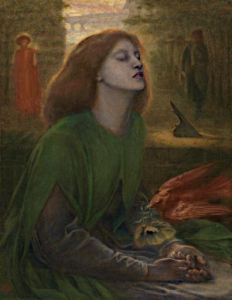 The Rossettis’ approach to art, love and lifestyles are considered revolutionary, and this will be thoroughly explored in an immersive show, using spoken poetry, drawings, paintings, photography, design and more.
The Rossettis’ approach to art, love and lifestyles are considered revolutionary, and this will be thoroughly explored in an immersive show, using spoken poetry, drawings, paintings, photography, design and more.
This is the first retrospective of Dante Gabriel Rossetti at Tate and the largest exhibition of his iconic pictures in two decades.
It will also be the most comprehensive exhibition of Elizabeth Siddal’s work for 30 years, featuring rare surviving watercolours and important drawings.
The Rossettis will take a fresh look at the fascinating myths surrounding the unconventional relationships between Dante Gabriel Rossetti, Elizabeth Siddal, Fanny Cornforth and Jane Morris.
The Rossettis exhibition book
by Carol Jacobi and James Finch
hardback
Dimensions 27.5 x 23 cm
Material FSC certified paper and card
ISBN 9781849768412
£40
This visually captivating hardback exhibition book is devoted to the radical Rossetti generation.
Explore the Rossettis’ revolutionary approach to art, love and lifestyles through a collection of thematic essays containing fresh and surprising research, accompanied by beautiful Pre-Raphaelite illustrations.
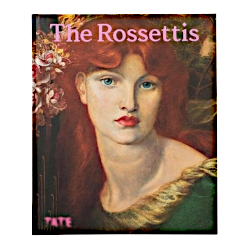 The Rossettis takes a fresh look at the fascinating myths surrounding the unconventional relationships between Dante Gabriel Rossetti, Elizabeth Siddal, Fanny Cornforth and Jane Morris. Featuring artworks and writings by Dante Gabriel, Christina and Elizabeth (née Siddal), the book distinguishes the Rossettis and foregrounds their countercultural roles.
The Rossettis takes a fresh look at the fascinating myths surrounding the unconventional relationships between Dante Gabriel Rossetti, Elizabeth Siddal, Fanny Cornforth and Jane Morris. Featuring artworks and writings by Dante Gabriel, Christina and Elizabeth (née Siddal), the book distinguishes the Rossettis and foregrounds their countercultural roles.
The catalogue accompanies the first retrospective of Dante Gabriel Rossetti at Tate and the largest exhibition of his iconic pictures in two decades, and what will also be the most comprehensive exhibition of Elizabeth Siddal’s work for 30 years, featuring rare surviving watercolours and important drawings.
The publication is edited by Carol Jacobi, Curator, British Art 1850—1915 at Tate and James Finch, Assistant Curator, Nineteenth Century Art at Tate. It features contributions by:
– Chiedza Mhondoro, Assistant Curator, Historic British Art at Tate – Dinah Roe, Reader in Nineteenth Century Literature at Oxford Brookes University – Glenda Youde, a writer and researcher based at University of York – Liz Prettejohn, Professor of Art History at University of York – Jan Marsh, a writer, curator and specialist in the Pre-Raphaelite period – Gursimran Oberoi, an associate teaching fellow at University of Surrey – Margaretta S. Frederick, the former Annette Woolard-Provine Curator of the Bancroft Collection of Pre-Raphaelite Art at Delaware Art Museum – Wendy Parkins, Professor of Victorian Literature and the Director of the Centre for Victorian Literature and Culture at the University of Kent
• fleursdumal.nl magazine
More in: *The Pre-Raphaelites Archive, - Book News, - Bookstores, Archive Q-R, Archive Q-R, Art & Literature News, Exhibition Archive, FDM in London, History of Britain, Illustrators, Illustration, Morris, William, Rossetti, Christina, Rossetti, Dante Gabriel, Siddal, Lizzy
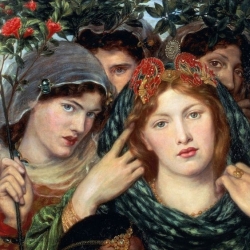
A New-Year’s Burden
Along the grass sweet airs are blown
Our way this day in Spring.
Of all the songs that we have known
Now which one shall we sing?
Not that, my love, ah no!—
Not this, my love? why, so!—
Yet both were ours, but hours will come and go.
The grove is all a pale frail mist,
The new year sucks the sun.
Of all the kisses that we kissed
Now which shall be the one?
Not that my love, ah no!—
Not this, my love?—heigh-ho
For all the sweets that all the winds can blow!
The branches cross above our eyes,
The skies are in a net:
And what’s the thing beneath the skies
We two would most forget?
Not birth, my love, no, no,—
Not death, my love, no, no,—
The love once ours, but ours long hours ago.
Dante Gabriel Rossetti
(1828 – 1882)
A New-Year’s Burden
• fleursdumal.nl magazine
More in: *The Pre-Raphaelites Archive, Archive Q-R, Archive Q-R, Lizzy Siddal, Rossetti, Dante Gabriel
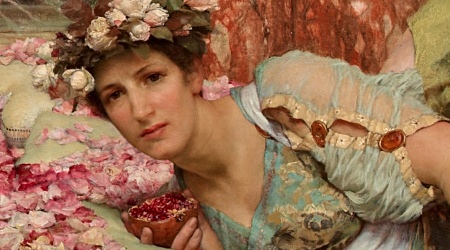
alma-tadema (1836 – 1912)
de meest succesvolle schilder van de 19e eeuw
Verleidelijke Romeinse vrouwen gesluierd in fijne gewaden tegen dromerige vergezichten, mijmerende geliefden op bijna doorschijnend marmeren bankjes en dames die hun tijd doorbrengen met pootjebaden, vissen voeren en luieren. Maar ook een farao met zijn stervende zoon in zijn armen en een nietsvermoedend feestend gezelschap dat elk moment verstikt gaat worden onder een lawine van rozenblaadjes. Alma-Tadema neemt ons mee naar scenes uit de klassieke oudheid en brengt deze tijd, als eerste, echt tot leven. Hij verbeeldt de oudheid zo mooi en overtuigend, dat regisseurs zijn schilderijen gebruiken als blauwdruk voor spektakelfilms als Gladiator. Uit heel de wereld komen meer dan tachtig topschilderijen van een van de meest succesvolle schilders van de 19de eeuw naar Leeuwarden. Samen met persoonlijke voorwerpen en filmfragmenten geven zij een inkijk in zijn wereld.
van lourens naar sir lawrence
Alma-Tadema wordt in 1836 geboren als de Friese Lourens. Na zijn opleiding aan de kunstacademie in Antwerpen vertrekt hij voor de liefde naar Londen, waar hij zich laat naturaliseren tot Engelsman en zichzelf Lawrence gaat noemen. Al snel wordt hij ontdekt door het grote publiek en zijn roem is ongekend, vooral in Engeland en Amerika. In 1899 wordt hij zelfs geridderd en gaat voortaan als Sir door het leven. Alma-Tadema stierf in 1912 en ligt begraven in de St. Paul’s Cathedral in Londen.
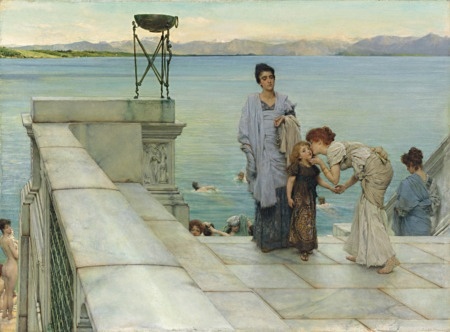
wereldfaam
Tijdens zijn leven wordt Alma-Tadema wereldberoemd met zijn werk. Hij schildert in opdracht van welgestelde zakenlieden en weet als geen ander zijn netwerk te cultiveren. Als een ware entertainer vermaakt hij op chique soirees de Londense high society. De opdrachten blijven binnenstromen en Tadema verdient een fortuin. Zo wordt hij een van de meest succesvolle schilders van de 19de eeuw. Ook tegenwoordig zijn werken van de geridderde schilder in het bezit van grote namen als George Lucas, de steenrijke Amerikaanse William Vanderbilt, de Getty familie, Andrew Lloyd Webber en Jack Nicholson. Zelfs ons koningshuis is de trotste eigenaar van een Tadema.
tadema en hollywood
Sinds zijn huwelijksreis naar Rome en Pompeï is Alma-Tadema gefascineerd door de klassieke oudheid. Hij is de eerste schilder die deze tijd met zoveel zorg en precisie in beeld brengt. Menig regisseur baseert zich op zijn schilderijen bij het maken van historische blockbusters zoals The Ten Commandments(1956). Ook nu nog; Tadema’s werk is een directe inspiratiebron voor Ridley Scott voor Gladiator (2000). In de tentoonstelling wordt glashelder hoe Tadema de filmwereld heeft beïnvloed. Daarnaast is er een bijpassend filmprogramma in samenwerking met Slieker Film en EYE filmmuseum.
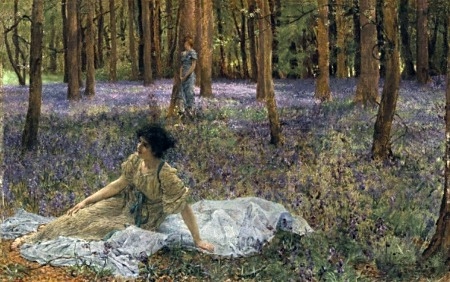
grootste collectie
Het museum beschikte al over de grootste Alma-Tadema-collectie van Nederland, deels gekregen van Alma-Tadema en zijn dochters Laurence en Anna. In het najaar van 2015 doet het Fries Museum de grootste aankoop uit de historie van het museum: Tadema’s Entrance of the theatre. Door deze aankoop kan het Fries Museum als enige museum in Nederland de volledige ontwikkeling tonen die de schilder in zijn carrière doormaakte.
audiotour
Alma-Tadema wekt met zijn schilderijen verhalen uit de oudheid tot leven. Maar welke verhalen vertelt hij eigenlijk en welke symboliek schuilt er achter de objecten die we in zijn werken zien? In een levendige audiotour vertelt acteur Peter Tuinman je alles over zeventien hoogtepunten van de tentoonstelling. Je kiest zelf over welke schilderijen je meer wilt horen waardoor je in alle vrijheid door de tentoonstelling kunt lopen. De verhalentour kost slechts € 1,- per persoon en is ook online te reserveren. Voor buitenlandse bezoekers is er een Engelstalige Storytour beschikbaar.
Het Fries Museum heeft voor deze vernieuwende tentoonstelling over Alma-Tadema de Turing Toekenning 2015 gewonnen. De Turing Foundation kent deze prijs ter waarde van 500.000 euro eens in de twee jaar toe voor het beste tentoonstellingsplan van een Nederlands museum.
De tentoonstelling Alma-Tadema, klassieke verleiding is onderdeel van Leeuwarden-Fryslân Culturele Hoofdstad van Europa 2018. Voor deze tentoonstelling en het begeleidende filmprogramma werkt het Fries Museum samen met EYE filmmuseum en Slieker Film.
Alma-Tadema – klassieke verleiding is nog te zien tot en met 7 februari 2017.
Fries Museum
Wilhelminaplein 92
8911 BS Leeuwarden
T: 058 255 55 00
# Meer info op website friesmuseum
fleurdumal.nl magazine
More in: *The Pre-Raphaelites Archive, Art & Literature News, Exhibition Archive, The Ideal Woman, The talk of the town
De kunstenaar en zijn muze: liefde, begeerte, desillusie en onontkoombare verbondenheid
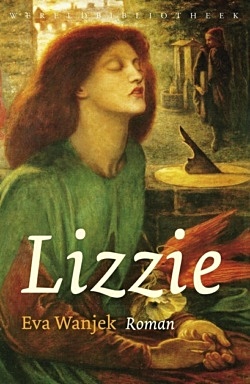 Een onconventionele relatie tussen twee bijzondere mensen leidt hen naar de toppen van de roem, maar ook naar afgronden van ellende en vertwijfeling: van drank, opium en vooral wederzijdse afhankelijkheid. Het is de symbiotische relatie van een gedreven kunstenaar die alles – ook zijn eigen geluk en dat van anderen – opoffert voor de kunst, en een vrouw die haar bestaansrecht ontleent aan haar uitzonderlijke schoonheid, terwijl ze faalt in haar eigen artistieke ambities.
Een onconventionele relatie tussen twee bijzondere mensen leidt hen naar de toppen van de roem, maar ook naar afgronden van ellende en vertwijfeling: van drank, opium en vooral wederzijdse afhankelijkheid. Het is de symbiotische relatie van een gedreven kunstenaar die alles – ook zijn eigen geluk en dat van anderen – opoffert voor de kunst, en een vrouw die haar bestaansrecht ontleent aan haar uitzonderlijke schoonheid, terwijl ze faalt in haar eigen artistieke ambities.
Lizzie geeft een levendig en panoramisch beeld van het bruisende Londen van de 19de eeuw, met zijn culturele elite, zijn bohémiens en zijn zelfkant. Hij biedt zowel kostuumdrama en ‘Gothic horror’ als erotische en indringende psychologische scènes. Het is een groots opgezet drama, van de allereerste ontmoeting in 1849 tussen het onbekende naaistertje en het aanstormende genie, tot aan diens dood als beroemde, maar eenzame weduwnaar in 1882.
Lizzie is een boeiende roman, die alle facetten van een man-vrouwrelatie toont, van prille liefde en begeerte, via wederzijdse ontrouw, vervreemding en desillusie tot aan het besef van absolute lotsverbondenheid.
Eva Wanjek is het pseudoniem waaronder twee auteurs van Uitgeverij Wereldbibliotheek hun krachten hebben gebundeld: de romanschrijver Martin Michael Driessen en de dichteres Liesbeth Lagemaat.
De pers over Lizzie:
‘Een samenwerkingsverband tussen Martin Michael Driessen en Liesbeth Lagemaat leidt tot een historische roman waarin kunstzinnige verhevenheid en de liefde het pijnlijk afleggen tegen de zelfdestructie. ****’ NRC Handelsblad
‘De auteurs hebben dit tranentrekkende, vuistdikke verhaal schittering opgebouwd. beelden trekken als een film aan je voorbij en laten je niet los. En al ben je broodnuchter, raak je door hun liefdesgeschiedenis die gedoemd is te mislukken, bedwelmd, en leest die in één gelukzalige roes uit.’ Baarnsche Courant
Een fragment uit: ‘Lizzie’
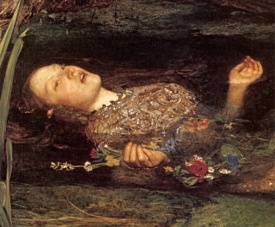 En als Miss Siddall maar lang genoeg in dit water ligt terwijl ik schilder, en vergeet waar ze is, dan krijg ik misschien juist de uitdrukking die ik zoek. Die van vergetelheid, van opgave, alsof ze op de wateren van de Lethe drijft. Misschien helpt een beetje laudanum. En ze is mooi genoeg om ook dan nog begeerlijk te zijn. Want dat is waarom het gaat. Ophelia moet in haar dood begeerlijk zijn. Want alleen dan is het tragisch dat niemand haar ooit zal beminnen.
En als Miss Siddall maar lang genoeg in dit water ligt terwijl ik schilder, en vergeet waar ze is, dan krijg ik misschien juist de uitdrukking die ik zoek. Die van vergetelheid, van opgave, alsof ze op de wateren van de Lethe drijft. Misschien helpt een beetje laudanum. En ze is mooi genoeg om ook dan nog begeerlijk te zijn. Want dat is waarom het gaat. Ophelia moet in haar dood begeerlijk zijn. Want alleen dan is het tragisch dat niemand haar ooit zal beminnen.
Hij vroeg zich af wie van hen Miss Siddall als eerste bezitten zou. Ik niet, dacht hij, ze is zo kwetsbaar, daar zit je voor de rest van je leven aan vast. Hunt was te rechtschapen, die zou alleen met zijn wettige echtgenote naar bed gaan. En Deverell ook niet. Walter was idolaat van haar, maar hij was een ziek man. Het zou Dante wel zijn. Lizzie was Dante’s meisje.
Nog een fragment uit: ‘Lizzie’
 Ik ben Rossetti,’ zegt hij en ik hoor zijn stem vertraagd, alsof hij weerkaatst wordt door een gewelf. ‘Mijn naam is Dante Gabriel Rossetti, u zult wel nooit van mij gehoord hebben. Ik ben dichter en schilder.
Ik ben Rossetti,’ zegt hij en ik hoor zijn stem vertraagd, alsof hij weerkaatst wordt door een gewelf. ‘Mijn naam is Dante Gabriel Rossetti, u zult wel nooit van mij gehoord hebben. Ik ben dichter en schilder.
Er is een beweging, de Prerafaëlitische Broederschap… zo noemen we ons… waarvan ik de leider ben. En nu ik u heb gezien, wil ik u vragen…’
Als een mens ooit werd opgetild van de aarde, dan werd ik het, nu. Ik wist niet wat me overkwam. Maar ik wist wel wat ik nu wilde zeggen…
Ze glimlachte en reciteerde – bevangen, als iemand die onwennig op een bruiloft of uitvaart spreekt en bang is iets verkeerds te zeggen – twee van zijn eigen verzen, uit ‘The Blessed Damozel’:
I’ll take his hand and go with him
To the deep wells of light…
Hij knielde voor haar en kuste haar hand. Het was voor het eerst in haar leven dat een man voor haar knielde. Nu mocht en kon er niets meer gezegd worden.
In de deuropening draaide hij zich om. Ze zat nog steeds op haar stoel, haar ene hand op het tafelblad, blank en haast doorschijnend, als door een Hollandse meester geschilderd. Ze keek over haar schouder naar het beroete raam, dat nauwelijks licht doorliet, en scheen weer onbereikbaar, in haar eigen gedachten verzonken. Was ze zo, of poseerde ze? Wat het ook was, ze deed het goed.
Voordat Dante de deur weer sloot, maakte hij met zachte stem de strofe af:
As unto a stream we will step down,
And bathe there in God’s sight
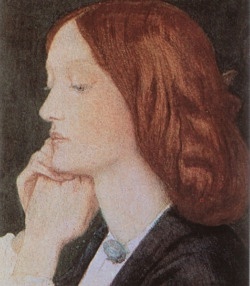 Eva Wanjek:
Eva Wanjek:
Lizzie
paperback met flappen
15×23 cm.
464 pagina’s
ISBN 9789028426160
prijs € 24,95
Uitgeverij Wereldbibliotheek
Johannes Vermeerstraat 63, 1071 DN Amsterdam
Tel: 020 570 61 00
Fax: 020 570 61 99
E-mail: info@wereldbibliotheek.nl
fleursdumal.nl magazine
More in: *The Pre-Raphaelites Archive, - Book News, Archive W-X, Lizzy Siddal, Rossetti, Dante Gabriel, Siddal, Lizzy
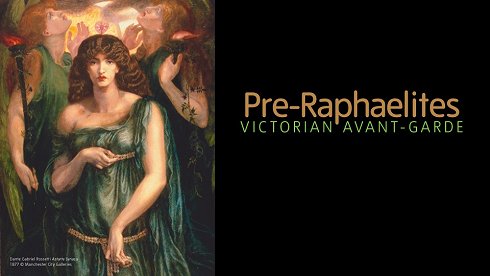
Tate Britain London
Pre-Raphaelites:
Victorian Avant-Garde
until 13 January 2013
Combining rebellion and revivalism, scientific precision and imaginative grandeur, the Pre-Raphaelite Brotherhood shook the art world of mid-nineteenth-century Britain. This autumn, Tate Britain stages the largest survey of the group since 1984, offering a rare chance to see around 180 works brought together. Exploring their revolutionary ideas about art and society, this exhibition sets out to show that the Pre-Raphaelites were Britain’s first modern art movement. It includes famous and less familiar Pre-Raphaelite paintings as well as sculpture, photography and the applied arts.

Led by Dante Gabriel Rossetti, William Holman Hunt and John Everett Millais, the Pre-Raphaelites rebelled against the art establishment of their day. Their unflinchingly radical style, inspired by the purity of early Renaissance painting, defied convention, provoked critics and entranced audiences.
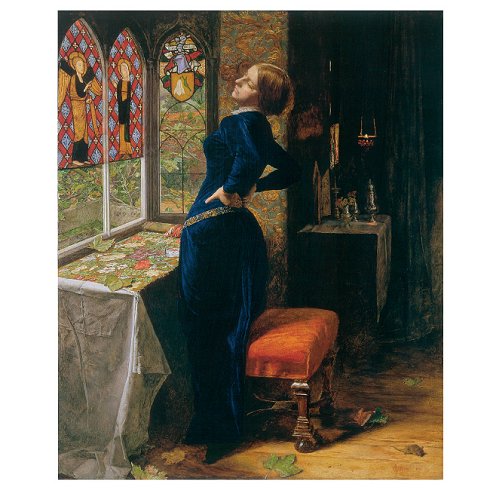
Today, renowned for their exquisitely detailed, vividly coloured style, the works of the Pre-Raphaelites are among the best known of all English paintings. This exhibition traces developments from their formation in 1848 through to their late Symbolist creations of the 1890s. It shows that whether their subjects were taken from modern life or literature, the New Testament or classical mythology, the Pre-Raphaelites were committed to the idea of art’s potential to change society. In pieces such as Madox Brown’s The Last of England 1852-5 (Birmingham Museums and Art Gallery) they served this aim by representing topical social issues and challenging prevailing attitudes. Other artworks, including Burne-Jones’s King Cophetua and the Beggar Maid 1884 (Tate), took a different approach, embracing beauty and ornamentation as a resistance to an increasingly industrialised society.

Pre-Raphaelites: Victorian Avant-Garde offers the chance to see well-known paintings such as Ophelia 1851-2 (Tate) by John Everett Millais (1829-1896) and The Scapegoat 1854-5 (National Museums Liverpool) by William Holman Hunt (1827-1910). Highlights include masterpieces rarely seen in the UK such as Rossetti’s Found 1854-5/1859-81 (Delaware Art Museum, USA), Burne-Jones’s Perseus series (Staatsgalerie, Stuttgart) and Holman Hunt’s psychedelic The Lady of Shalott 1886-1905 (Wadsworth Atheneum, Connecticut). Spectacular late works by Hunt, Millais, Rossetti and Madox Brown are also united for the exhibition.

In contrast to previous Pre-Raphaelite surveys, this exhibition juxtaposes paintings with works in other media including textiles, stained glass and furniture, showing the influence of Pre-Raphaelitism in the early development of the Arts and Crafts movement and the socialist ideas of the poet, designer and theorist, William Morris (1834-1896). Bringing together furniture and objects designed by Morris‘s firm, of which many Pre-Raphaelite artists were part, it demonstrates how Morris’s iconography for British socialism ultimately evolved out of Pre-Raphaelitism. Highlights include Philip Webb and Burne-Jones’s The Prioress’s Tale wardrobe 1858 and the embroideries made by Jane and May Morris for William Morris’s bed at Kelmscott Manor c1891.

Pre-Raphaelites: Victorian Avant-Garde is curated by Tim Barringer, Paul Mellon Professor of the History of Art, Yale University; Jason Rosenfeld, Distinguished Chair and Professor of Art History at Marymount Manhattan College, New York; Alison Smith, Lead Curator, 19th Century British Art at Tate Britain. It is accompanied by a catalogue from Tate Publishing. The exhibition will tour to the National Gallery of Art, Washington DC (17 February – 19 May 2013), The Pushkin State Museum of Fine Arts, Moscow (Summer 2013) and the Mori Art Center, Tokyo (Spring 2014).
fleursdumal.nl magazine
More in: *The Pre-Raphaelites Archive
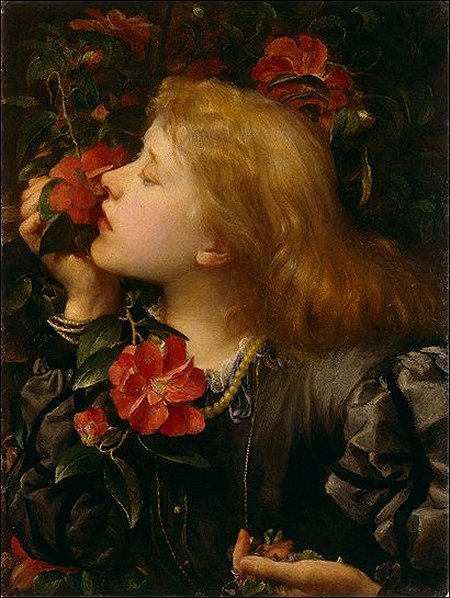
Choosing’- George Frederic Watts – London 1864 – Oil on strawboard – National Portrait Gallery, London – This painting depicts the young actress Ellen Terry reaching out to the opulent but scentless camellia and discarding the common, but fragrant violets in her hand
Victoria & Albert Museum London
until 17 July 2011 last chance to see
THE CULT OF BEAUTY
THE AESTHETIC MOVEMENT 1860-1900
The exhibition has been arranged in four main chronological sections, charting the development of the Aesthetic Movement in art and design through the decades from the 1860s to the 1890s. As well as paintings, prints and drawings, the show will include examples of all the ‘artistic’ decorative arts, together with drawings, designs and photographs, as well as portraits, fashionable dress and jewellery of the era. Literary life will be represented by some of the most beautiful books of the day, whilst a number of set-pieces will reveal the visual world of the Aesthetes, evoking the kind of rooms and ensembles of exquisite objects through which they expressed their sensibilities.
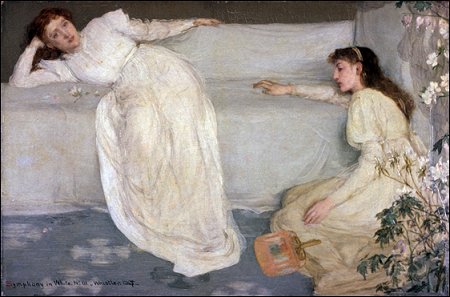
‘Symphony in White, No. 3′- James McNeill Whistler – London 1867 – Oil on canvas – The Trustees of the Barber Institute of Fine Arts, University of Birmingham – One critic claimed that this painting was ‘not precisely a symphony in white’ because it also included other colours. Whistler retorted that ‘a symphony in F…contains no other note, but a continued repetition of F, F, F-Fool!’
The search for new beauty
1860s
In the 1860s the new and exciting ‘Cult of Beauty’ united, for a while at least, romantic bohemians such as Dante Gabriel Rossetti (and his younger Pre-Raphaelite followers William Morris and Edward Burne-Jones), maverick figures such as James McNeill Whistler, then fresh from Paris and full of ‘dangerous’ French ideas about modern painting, and the ‘Olympians’ – the painters of grand classical subjects who belonged to the circle of Frederic Leighton and G.F.Watts. Choosing unconventional models, such as Rossetti’s muse Lizzie Siddal or Leighton’s sultry favourite ‘La Nanna’, these painters created entirely new types of female beauty.
Rossetti and his friends were also the first to attempt to realise their imaginative world in the creation of ‘artistic’ furniture and the decoration of rooms. In this period, artists’ houses and their extravagant lifestyles became the object of public fascination and sparked a revolution in the architecture and interior decoration of houses that led to a widespread recognition of the need for beauty in everyday life.
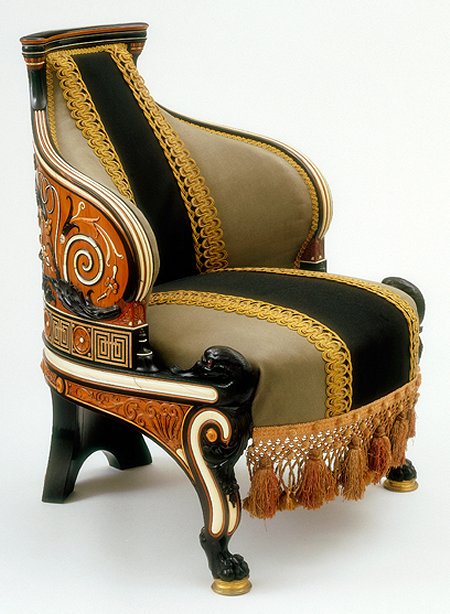
Armchair – Lawrence Alma-Tadema – Made by Johnstone, Norman & Co. London 1884-6 – Mahogany, with cedar and ebony veneer, inlay of several woods, ivory and abalone shell – Museum no. W.25:1-1980 – This armchair was designed for a ‘Greek parlour’ and belonged to Henry Gourdon Marquand, the second director of the Metropolitan Museum of Art in New York
Art for Arts Sake
1870s-1880s
One of the most important examples of the mutual influence between artists and designers is to be found in the startling collaborations between James McNeill Whistler and the architect E.W.Godwin who designed the painter’s studio, The White House, and created some of the most innovative furniture of the day. Characterised equally by elegance and eccentricity, Whistler and Godwin’s work drew upon influences as diverse as ancient Greek art and the Japanese prints and other artifacts just beginning to arrive in Europe.
In the 1870s, the leading Aesthetic artists, Whistler, Leighton, Watts, Albert Moore and Burne-Jones evolved a new kind of self-consciously exquisite painting in which mood, colour harmony and beauty of form were all, and subject played little or no part. The opening of the Grosvenor Gallery (with its famous ‘greenery-yallery’ walls) in 1877 at last gave the Aesthetic painters a fashionable and glamorous showcase for their much-discussed art. But the decade closed with intense controversy exemplified by the critic John Ruskin’s savage attack on Whistler, which prompted the painter’s spirited defence of the ideals of ‘Art for Art’s Sake’ in his writings and by the staging of his own exhibitions.
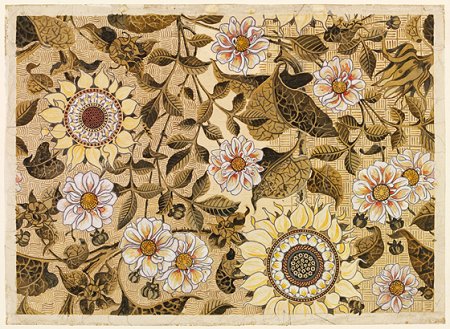
Design for ‘The Sunflower’ wallpaper – Bruce James Talbert – Made by Jeffrey & Co. London 1878 – Watercolour and body colour – Museum no. E.37-1945 Given by Mrs Margaret Warner – The wallpaper manufacturer Jeffrey & Co. employed Aesthetic designers such as Bruce Talbert to bring ‘art’ to their products
Beautiful people and Aesthetic houses
1870s-1880s
The immense success of the Grosvenor Gallery signalled the emergence of a new artistic elite whose social prestige offered an unprecedented challenge to the Royal Academy. Aesthetic painting became the fashionable enthusiasm of a circle that was grand, wealthy and intellectual. As well as buying paintings these new patrons were keen to embrace Aesthetic ideals, commissioning portraits and even adopting the styles of ‘artistic’ dress.
The rise of Aestheticism in painting was paralleled in the decorative arts by a new and increasingly widespread interest in the decoration of houses. Many of the key avant-garde architects and designers interested themselves not only in working for wealthy clients but also in the reform of design for the middle-class home. The notion of ‘The House Beautiful’ became a touchstone of cultured life.
Attracted by the growing popularity of Aesthetic taste, many of the leading firms making furniture, ceramics, domestic metalwork and textiles courted artists such as Walter Crane and a growing band of professional designers, most notably Christopher Dresser. Co-inciding with a period of unprecedented expansion of domestic markets, the styles favoured by Aesthetic designers were among the very first to be exploited and disseminated widely through commercial enterprise.
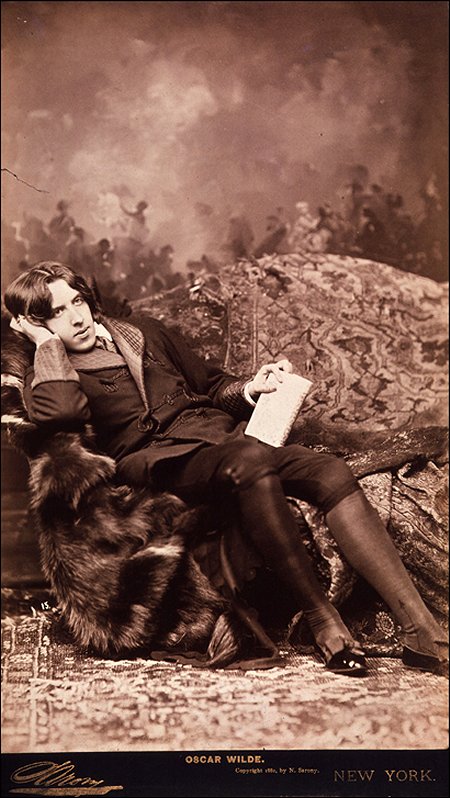
‘Oscar Wilde’ – Napoleon Sarony – New York 1882 – Albumen panel print – National Portrait Gallery, London – Sarony’s photographs, taken at the beginning of Oscar Wilde’s American lecture tour, fixed his image in the public imagination as the epitome of the Aesthete
Late-flowering beauty
1880s-1890s
Oscar Wilde, the first celebrity style-guru, invented a brilliant pose of ‘poetic intensity’, but initially made his name promoting the idea of ‘The House Beautiful’. By the 1880s Britain was in the grip of the ‘greenery-yallery’ Aesthetic Craze, lovingly satirised by Gilbert and Sullivan in their famous comic opera Patience and by the caricaturist George Du Maurier in the pages of Punch.
In the last decade of Queen Victoria’s reign the Aesthetic Movement entered its final, fascinating Decadent phase, characterised by the extraordinary black-and-white drawings of Aubrey Beardsley in The Yellow Book.
The exhibition ends with a superb group of the greatest late Aesthetic paintings, including masterpieces such as Leighton’s Bath of Psyche, Moore’s Midsummer and Rossetti’s final picture The Daydream, shown alongside the sensuous nude figures sculpted in bronze and precious materials by Alfred Gilbert and other brilliant younger exponents of ‘The New Sculpture’.
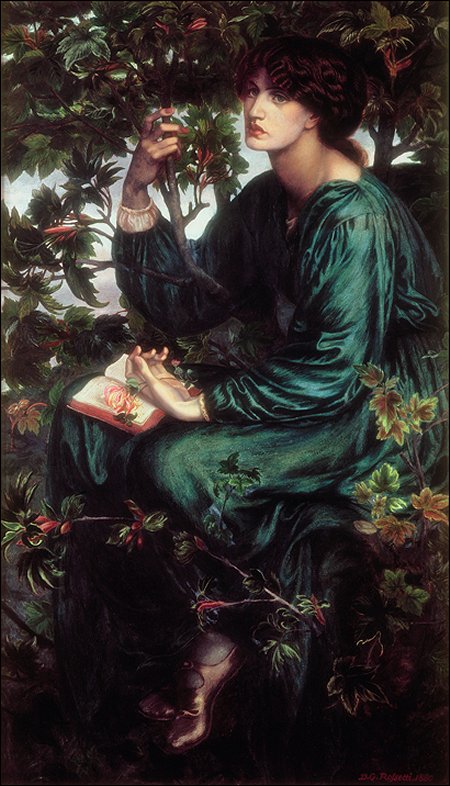
‘The Day Dream’ – Dante Gabriel Rossetti – 1880 London – Oil on canvas – Museum no. CAI.3 – Bequeathed by Constantine Alexander Ionides – This is one of the last major oil paintings that Rossetti completed. The lush green leaves match the fullness of Jane Morris’s figure in her green silk dress
Victoria & Albert Museum London
until 17 July 2011 last chance to see
THE CULT OF BEAUTY: THE AESTHETIC MOVEMENT 1860-1900
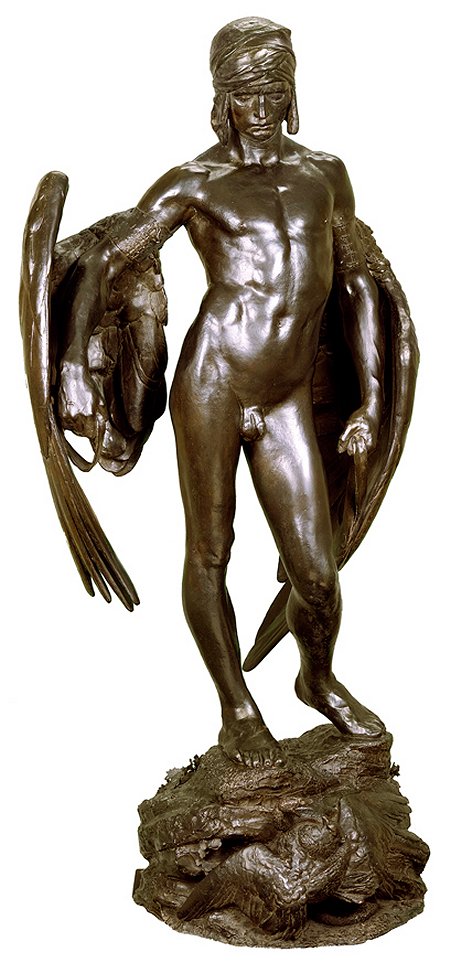
‘Icarus’ – Alfred Gilbert – Rome and Naples – Cast in the foundry of Sabatino de Angelis 1884 – Bronze – Amgueddfa Cymru – National Museum Wales – © National Museum of Wales – Frederic Leighton commissioned Gilbert to produce a bronze statue, leaving him to choose the subject. Gilbert took the mythical figure of Icarus, the ambitious youth who flew too close to the sun
fleursdumal.nl magazine
More in: *The Pre-Raphaelites Archive

.jpg)
Dante Gabriel Rossetti
(1828-1882)
Autumn Song
Know’st thou not at the fall of the leaf
How the heart feels a languid grief
Laid on it for a covering,
And how sleep seems a goodly thing
In Autumn at the fall of the leaf?
And how the swift beat of the brain
Falters because it is in vain,
In Autumn at the fall of the leaf
Knowest thou not? and how the chief
Of joys seems–not to suffer pain?
Know’st thou not at the fall of the leaf
How the soul feels like a dried sheaf
Bound up at length for harvesting,
And how death seems a comely thing
In Autumn at the fall of the leaf?



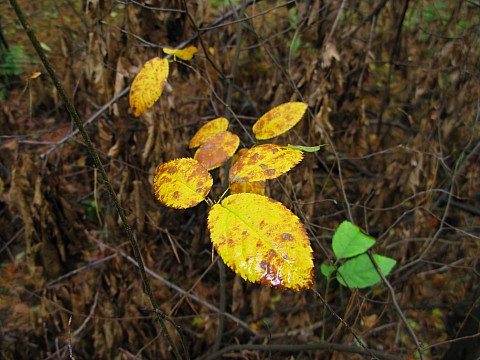
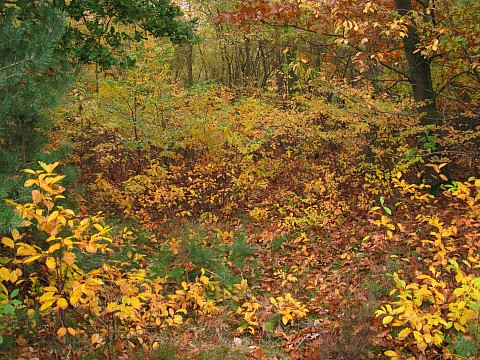



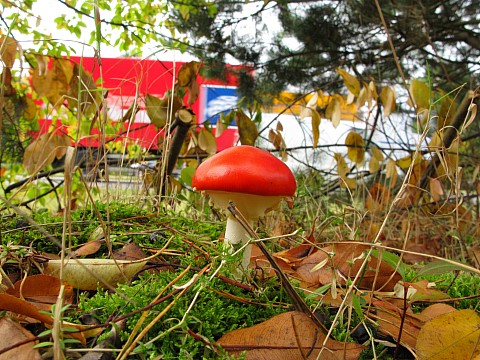
Ton van Kempen photos: Autumn 3
D.G. Rossetti poetry
fleursdumal.nl magazine
More in: *The Pre-Raphaelites Archive, 4SEASONS#Autumn, Archive Q-R, Rossetti, Dante Gabriel, Ton van Kempen Photos
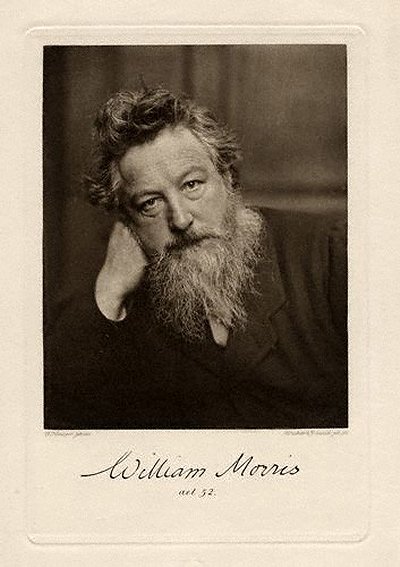
William Morris
(1834-1896)
Spring’s Bedfellow
Spring went about the woods to-day,
The soft-foot winter-thief,
And found where idle sorrow lay
‘Twixt flower and faded leaf.
She looked on him, and found him fair
For all she had been told;
She knelt adown beside him there,
And sang of days of old.
His open eyes beheld her nought,
Yet ‘gan his lips to move;
But life and deeds were in her thought,
And he would sing of love.
So sang they till their eyes did meet,
And faded fear and shame;
More bold he grew, and she more sweet,
Until they sang the same.
Until, say they who know the thing,
Their very lips did kiss,
And Sorrow laid abed with Spring
Begat an earthly bliss.
![]()
William Morris poetry
• fleursdumal.nl magazine
More in: *The Pre-Raphaelites Archive, 4SEASONS#Spring, Archive M-N, Archive M-N, Morris, William
.jpg)
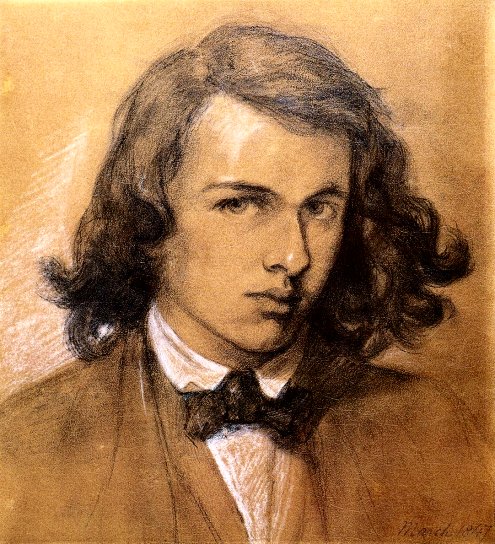
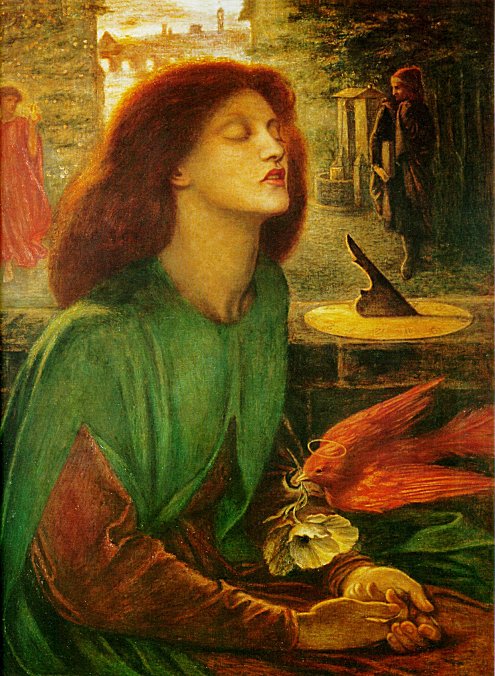
Fleursdumal.nl magazine Gallery of Poets’ Portraits:
Dante Gabriel Rossetti (1828-1882) &
Elizabeth (Lizzy) Siddal (1829-1862)
fleursdumal.nl magazine – magazine for art & literature
More in: *The Pre-Raphaelites Archive, Poets' Portraits
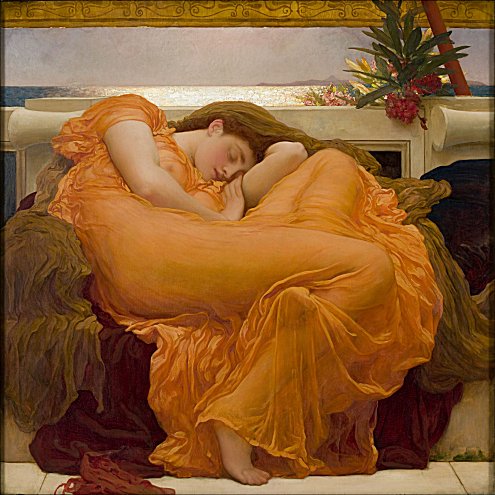
Frederic Leighton, Flaming June, ca. 1895, olieverf op doek, 119 x 119 cm,
Collectie Museo de Arte de Ponce,
Fundación Luis A. Ferré, Inc., Ponce, Puerto Rico
De Schone Slaapster
Victoriaanse schilderkunst uit het Museo de Arte de Ponce
4 juli 2009 t/m 20 september 2009
Gemeentemuseum Den Haag
Het prachtige Flaming June van Frederic Leighton (1830-1896) en vijf sprookjesachtige schilderijen van Edward Burne-Jones (1833-1898) vormen de hoogtepunten van een bijzondere tentoonstelling die van 4 juli tot en met 20 september 2009 te zien is in het Gemeentemuseum Den Haag. Deze topstukken uit het Victoriaanse tijdperk maken deel uit van de collectie van het Museo de Arte de Ponce in Puerto Rico en zijn nu voor het eerst in Nederland te zien.
De prerafaëlieten leverden de belangrijkste Engelse bijdrage aan de negentiende-eeuwse schilderkunst. Kunstenaars als Dante Gabriel Rossetti (1828-1882), John Everett Millais (1829-1896) en William Hunt (1827-1910) hadden later grote invloed op stromingen als het Symbolisme en de Esthetic Movement rond Oscar Wilde. In de Victoriaanse tijd vonden hun hoofse ideeën over de mythische schoonheid van de vrouw navolging en werd er veel aandacht besteed aan de materiaalweergave van stoffen, marmer en bloemen.
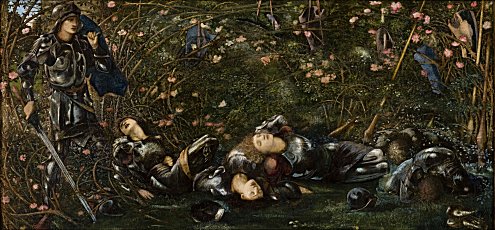
Sir Edward Coley Burne-Jones,
De prins treedt het woud binnen uit de kleine Doornroosje-serie,
1871 – 73, olieverf op doek, 61.28 x 129.54 cm,
Collectie Museo de Arte de Ponce, Fundación Luis A. Ferré, Inc., Ponce, Puerto Rico
Frederic, Lord Leighton schilderde zijn meesterlijke Flaming June rond 1895. Het is een beeld van een onschuldige, slapende vrouw in een oranje, doorschijnende jurk waaronder haar vrouwelijke vormen voorzichtig worden bloot gegeven. De bank waarop ze ligt is bekleed met kussens en rode doeken, op de achtergrond de glinstering van de zon in de zee. Met de weelderige lijnen en warme zonnige kleuren is dit schilderij een voorbeeld van Leightons voorliefde voor klassieke schoonheid en harmonie.
Een ander indrukwekkend doek is het monumentale De slaap van Koning Arthur in Avalon, van Edward Burne-Jones. Dit ruim zes meter brede schilderij wordt beschouwd als zijn ultieme meesterwerk waar hij van 1881 tot op de dag voor zijn dood in 1898 aan werkte om de compositie te perfectioneren. Door het grote formaat kan het schilderij alleen opgerold vervoerd worden en heeft het sinds de aankoop in de jaren 1960 het museum in Puerto Rico nooit meer verlaten. Het is dan ook zeer bijzonder dat het nu voor het eerst weer in Europa is te zien.
.jpg)
Sir Edward Coley Burne-Jones, De slaap van Koning Arthur in Avalon,
olieverfschets, ca. 1881, olieverf op doek, 83,2 x 288,9 cm,
Collectie Museo de Arte de Ponce, Fundación Luis A. Ferré, Inc., Ponce, Puerto Rico
In zijn onderwerpskeuze had Burne-Jones een voorkeur voor de fabelachtige wereld van sprookjes en legendes waarin hij zijn ideale wereld kon verbeelden. De cyclus van Doornroosje bijvoorbeeld bestaat uit drie fantastische werken waarin slapende menselijke figuren worden omringd door een zee van rozen. Hierin is goed te zien hoe Burne-Jones zich liet inspireren door het classicisme; zijn mensen zijn bijna onwerkelijk mooi, zijn draperieën vallen sierlijk en de composities zijn evenwichtig.
In de expositie zijn verder nog schilderijen opgenomen van onder andere Millais, Rossetti, Seddon en Hunt. Deze intieme, hoog kwalitatieve tentoonstelling bestaat uit tien schilderijen, zes tekeningen en een gouache, en is georganiseerd in samenwerking met het Museo del Prado in Madrid en het Memphis Brooks Museum of Art in de Verenigde Staten.
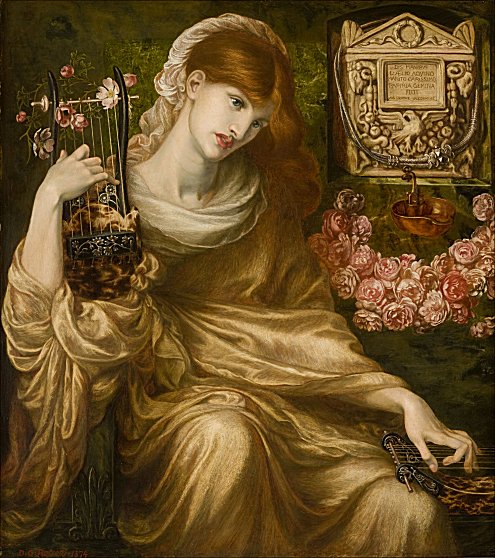
Dante Gabriel Rossetti, Romeinse weduwe, 1874,
olieverf op doek, 104,8 x 93,3 cm, Collectie Museo de Arte de Ponce,
Fundación Luis A. Ferré, Inc., Ponce, Puerto Rico
fleurdumal.nl magazine
More in: *The Pre-Raphaelites Archive, Art & Literature News
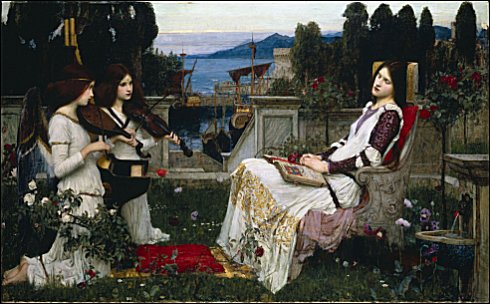
J. W. W A T E R H O U S E
(1849-1917)
Betoverd door vrouwen
Groninger Museum
14 december 2008 – 3 mei 2009
Het Groninger Museum presenteert van 14 december 2008 tot en met 3 mei 2009 de grootste overzichtstentoonstelling van werken van de wereldberoemde Britse kunstenaar John William Waterhouse (1849-1917) die ooit is georganiseerd. Vele kunstwerken komen uit Engeland, Ierland, Australië, Taiwan en Canada. De tentoonstelling toont schilderijen en tekeningen en wordt georganiseerd in samenwerking met de Royal Academy of Arts in Londen en het Montreal Museum of Fine Arts in Montreal.
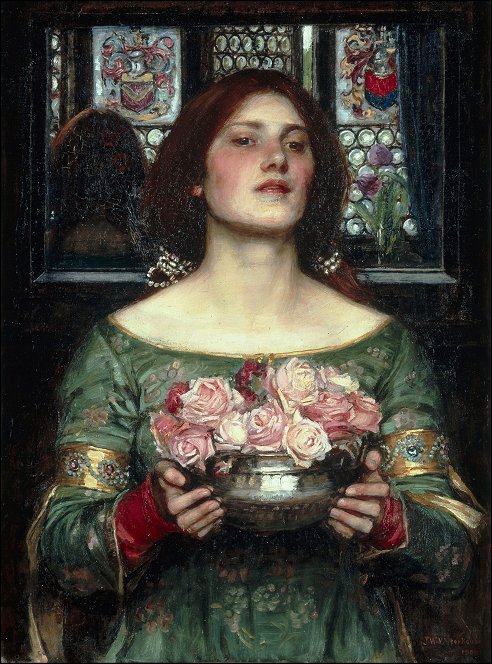
De internationale, reizende tentoonstelling J.W. Waterhouse (1849-1917). Schoonheid en Passie is de eerste grootschalige monografische expositie van het werk van Waterhouse sinds 1978. Het is bovendien de eerste tentoonstelling ooit, die de gehele carrière van Waterhouse zal onderzoeken en werken uit publieke en private collecties van over de hele wereld samen zal brengen.
De tentoonstelling toont het engagement van Waterhouse met hedendaagse onderwerpen, variërend van thema’s uit de Klassieke Oudheid en de Middeleeuwen tot spiritualiteit. Klassieke mythes, zoals geïnterpreteerd door Homerus en Ovidius, en een romantische fascinatie voor intense vrouwelijke passies, zoals die worden beschreven in de gedichten van John Keats, Alfred Tennyson en het werk van William Shakespeare, spelen een belangrijke rol binnen zijn oeuvre. Voorbeelden hiervan zijn de Lady of Shalott, Cleopatra, Ulysses and the Sirens en La Belle Dame Sans Merci.
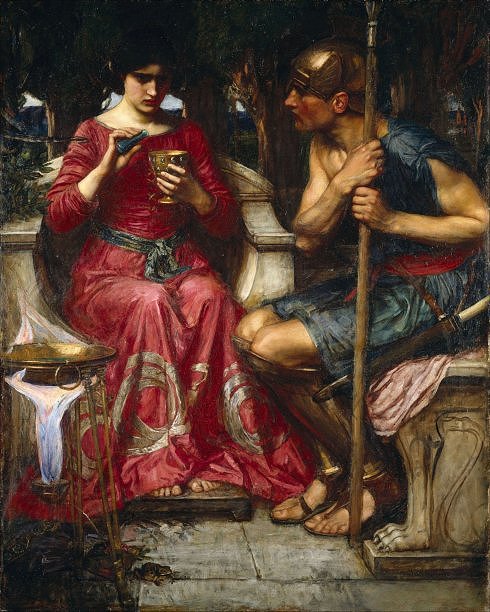
Hoewel de werken van J.W. Waterhouse door miljoenen mensen wereldwijd bewonderd worden, weet het publiek relatief weinig over de man zelf en zijn artistieke productie. De tentoonstelling in het Groninger Museum zal de meest beroemde werken van Waterhouse dan ook in de context van zijn gehele carrière plaatsen om aan te tonen waarom Waterhouse tot één van de meest belangrijke vertalers van klassieke en romantische tradities gerekend kan worden.
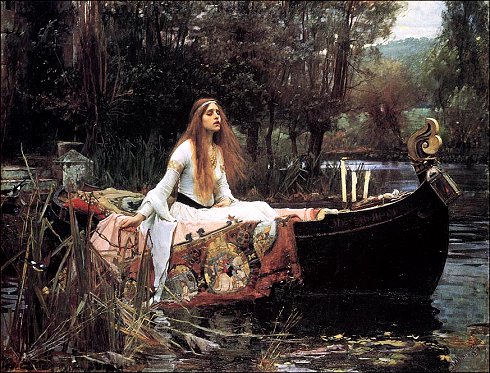
Tegenwoordig wordt Waterhouse vaak een ‘Moderne-Prerafaëliet’ genoemd, maar hij was ook een vertegenwoordiger van de nieuwe tijd en was zich volledig bewust van de spannende artistieke vernieuwingen in Parijs in de tweede helft van de negentiende eeuw. Hij voelde zich thuis in de betoverende wereld van mythen en sagen, maar heeft zich ook laten inspireren door poëzie en muziek en de lossere toon van het Frans impressionisme.
De passie van Waterhouse voor schoonheid leeft onmiskenbaar voort in de prachtige schilderijen en tekeningen die hij naliet en waarvan vele te zien zullen zijn in het Groninger Museum.
J.W. Waterhouse in Groninger Museum

fleursdumal.nl magazine – magazine for art & literature
More in: *The Pre-Raphaelites Archive, Art & Literature News
Thank you for reading Fleurs du Mal - magazine for art & literature